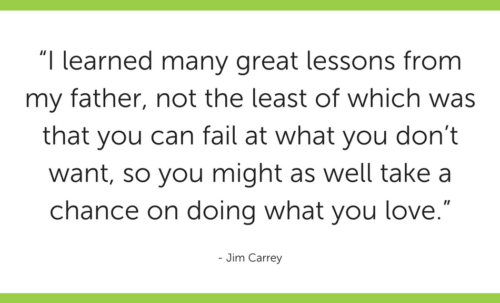4 Ways You are Self-Sabotaging Your Learning Efforts
I recently stumbled upon a video of Jim Carrey giving a commencement address at the Maharishi University of Management. All students, including Carrey, at the school practice Transcendental Meditation. You can watch the B-Roll here or the full speech here.
There were many gold nuggets in his address, however for this post about self-sabotaging your learning efforts, one stood out to me. He related the story of his father, who he says “could have been a great comedian,” but instead went down the safe road to be an accountant only to be laid off and lose his “safe” job.
Carrey’s message and one that powerfully hits home is – every one of us can undermine ourselves because we all are inclined to self-sabotage. There are two important questions we can ask ourselves when we find we are getting in our own way: Why and how did we get here? Why and how are getting in our own way when we are simply seeking to achieve what matters most to us?
Self-sabotage is an unconscious practice developed over time. However, knowledge is light. We want to be the best darn learning professionals we can be, we want to help people, we want to improve, be creative and innovate. To do this requires ongoing learning.
 Let’s talk about the four things you do to sabotage your learning efforts:
Let’s talk about the four things you do to sabotage your learning efforts:
1. Confusing Knowing with Learning
Knowing is remembering, not learning. Say that over and over to yourself. We watch Chicago Fire, this doesn’t make us fit to fight fires. We read Brain Rules by John Medina, but it doesn’t make us a neuroscientist. As Einstein said, “Any fool can know. The point is to understand.”
When we learn something new, we tend to assume that it creates a permanent imprint in our brains. This is simply not true. It’s critical to be aware that when trying to learn something new, you might not remember it for very long – therefore, allowing for reflection and time to practice retrieval will be essential. Here is a great interactive video on the brain and accelerated learning.
Watching a video on Camtasia will not teach you how to use it. Reviewing stunning elearning samples and taking notes doesn’t make you suddenly more creative and innovative. You must actively practice to learn the skills. A friend of mine shared with me that he is practicing his video editing skills by recording Hot Pot recipes and putting them into Camtasia. That’s a person who hasn’t confused knowledge with learning.
2. The fallacy of multi-tasking
Multi-tasking is something we’ve long been encouraged to practice, but it’s actually impossible. We jump from trying to learn that new whiz-bang application, but then email pings so you “multi-task” and respond. When we think we’re multi-tasking, we’re simply context-switching. Meaning we are just jumping back and forth between different tasks, splitting our time – not really doing the tasks at the same time.
The more we dilute our focus, the less chance we have of anything sticking. We are splitting our brain’s resources. So, when you are trying to learn something new, are you sabotaging yourself by multi-tasking? If so, ask why – Could it be “failure avoidance“?
3. Enveloped by failure avoidance
People dealing with failure avoidance essentially set low expectations and picture the worst-case scenario in very detailed ways, letting thinking run amok with the “what-ifs” and self-sabotaging their efforts to learn things by seeing all the worst possible outcomes.
Does this sound familiar? You want to try something new, but that one corner of your mind knows you’ll fail so you don’t try. When we’re more worried about being a failure than we are about trying new things, we don’t only miss out on discovering new opportunities, we fail to take risks.
As Jim Carrey pointed out in the video above, fear is usually the root cause preventing us from learning or trying new things —fear of the unknown or unfamiliar, fear of failure, fear that our impostor syndrome is correct, fear that we will have to face pain or rejection.
How to get over the fear? Every time you think “I can’t do this because . . .” try to kick your brain and focus on the small tasks that move you toward your goals. To crush fear, we must completely focus on the outcome that we want to create, this means dealing with fear with successful baby steps.
4. Falling for confirmation bias
Here’s the fallacy: You think you know something. You consider yourself an expert in your field – but are you? Are your opinions the result of years of finding information which confirmed what you believed while ignoring information which challenged those beliefs?
Does your research or work to try to prove something you already agree with instead of working to see the opposite side? When you wonder why something happens or what the truth may be, you stop looking for answers once your beliefs are confirmed?
“If one were to attempt to identify a single problematic aspect of human reasoning that deserves attention above all others, the confirmation bias would have to be among the candidates for consideration. Many have written about this bias, and it appears to be sufficiently strong and pervasive that one is led to wonder whether the bias, by itself, might account for a significant fraction of the disputes, altercations, and misunderstandings that occur among individuals, groups, and nations.” – Raymond S. Nickerson
How do we fight against what seems to be human nature? Research as though you were preparing for a debate. When you are up against something that confirms a belief, ask yourself what would happen if you were to make the opposite choice. Gather the data needed to defend the opposite view and compare it with the data used to support your original decision. Your ideas may still be incomplete, but they will be much more balanced. It’s here where true learning happens.
To Wrap this Up:
To support our continuous learning efforts, we need to understand what holds us back in the first place. Are we assuming we know something when in fact, do not? Are we trying to shove our learning into a timeframe that cannot support our efforts? Are we afraid we will fail, or that the topic is “above our pay grade” so subsequently we put learning new skills aside? Or are we so secure in what we know, we fail to see how things have shifted under our feet? What we knew 20 years ago may not be what we know now.
To move forward we must plan:
- Practice skills regularly — even the skills we use consistently. There’s always a better way.
- Carve out time to learn — time that is sacred, time that is uninterrupted.
- Plan baby steps and measure your success against those steps. The big picture can be scary, so tackle the little stuff.
- Realize we aren’t as smart as we think we are. When learning a new theory, look up both the pros and cons. Create arguments for both sides, then make an informed decision. Work your brain; don’t just stuff it full of information that is untested.
Continuous learning takes effort. So, get out of your own way and learn something new today.


 Let’s talk about the four things you do to sabotage your learning efforts:
Let’s talk about the four things you do to sabotage your learning efforts:



